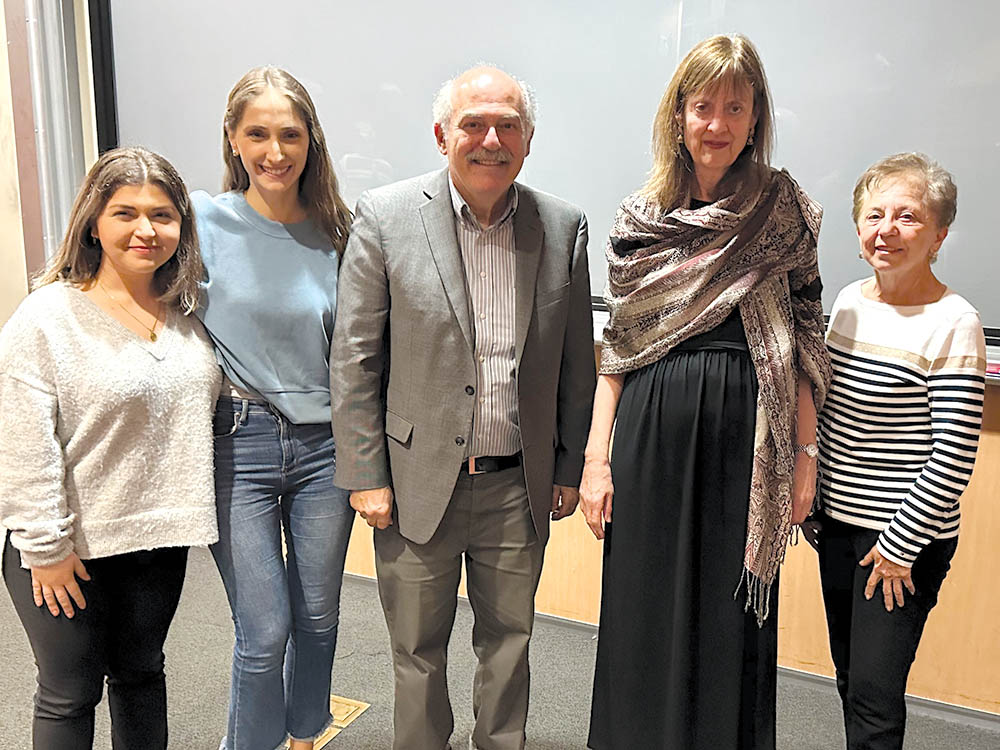Audience members were transported across the globe by “Armenians in Film: Six Short Films by Armenian Filmmakers,” which screened as part of the CineCulture Film Series at Fresno State on Friday, February 16. The two hundred and fifty people in attendance were able to view six films, each of which was distinct and presented a unique point of view.
The evening screening was made possible through the cooperation of AGBU Arts, CineCulture, the Armenian Studies Program, and the Armenian General Benevolent Union Greater Fresno Chapter.
Established in 2015, AGBU Arts’ “Armenians in Film” Film Series is an annual, international event that unites talented Armenian filmmakers from all over the globe. In the past nine years, over fifty short films have been screened by filmmakers from the United States, Canada, France, Brazil, the United Kingdom, China, Bulgaria, Armenia, and more.
Berberian Director of the Armenian Studies Program, Prof. Barlow Der Mugrdechian, and CineCulture director, Dr. Mary Husain, welcomed the audience and provided opening comments. Following the screening of the film, three artists joined the audience via Zoom to discuss their films. Tatiana Boudakian joined the audience from Brazil, Zela Margossian joined from Australia, and AGBU Arts director Hayk Arsenyan joined from New York.
The short-films and commentary by the guest speakers sparked thought-provoking questions and reflections among the attendees. From discussions on the Armenian Diaspora in Brazil to details on how one can submit a film to the “Armenians in Films” series, the evening was engaging and inspiring for all. The commentary provided valuable perspectives that deepened the audience’s understanding and appreciation of the works showcased.
Director Boudakian discussed volunteering with Birthright Armenia and the inspiration behind the title “Dehatsi,” her family’s journey of arriving in Brazil, and the unique nature of the Armenian community in Sao Paulo.
Musician Margossian shared the inspiration behind the sound-track of the film “The Road” and the diverse ethnic composition of her quintet. Hayk Arsenyan shared the history of how “Armenian Films” came about and how the films that were screened were chosen.
Director Tatiana Boudakian, in her film “Dehatsi: I was Another Place,” introduces the character Anush, a young Armenian wo-man who booked a one-way ticket to São Paulo, Brazil. The twenty-minute short film traces Anush’s struggle to adapt to a big city while maintaining her ethnic Armenian roots by serving as an Armenian and Russian language teacher in Brazil. The films reflects the director’s own experience growing up as an Armenian in Brazil.
In “Crossing the Blue,” director Victoria Aleksanyan paints the story of a woman, Anush, who in an effort to escape her abusive husband in post-Soviet Armenia, flees to America with her son. Once there, she is deported back to Armenia some years later without her son, who has gone missing.
In twelve minutes, Aleksanyan demonstrates the mental and physical agony of abusive relationships and the contradiction of wanting to return to one’s home but fearing it at the same time.
The timeline of the four-minute animated film, “Sunset,” is dictated by the amount of sunlight in each day. Director Kristine Khanamiryan artistically portrays the typical struggle of students to choose between the experiences with friends or dealing with their schoolwork. As the sun sets, the student is faced with a choice in how to pursue his life.
Documenting the 2020 Nagorno-Karabakh War, director Arman Ayvazyan in his film “Stones,” depicts the brutal realities of the forced emigration of the citizens from the region. In this seventeen-minute film, viewers witness the struggle of a group of volunteers, who defy the dangers try to save khatchkars [stone-crosses]. Traveling to the Lachin region in search of these khatchkars, and the fight to save them, made for an engrossing movie. Khatchkars, the historic and sacred remnants of Armenian history, are worth fighting for, to preserve the Armenian identity in the region.
An abstract, eight-minute short film, “The Road,” highlights the music Zela Margossian Quin-tet, an Armenian-Australian jazz band. Director Charlotte Mungomery utilizes alluring lighting, pantomime acting, and an original score to establish a disambiguating desert environment.
Director Vahan Grigoryan’s “The Mud,” is a comedic, mysterious short film that features Rafael and a lone goose. Their chaotic encounter results in eleven minutes of confusion when Rafael’s wife, Ashkhen, sees vanishing footprints and white feathers on the floor of their home.
Grigoryan playfully creates a digital piece of work that highlights the close-knit character of Armenians and the sometimes humorous results of misunderstandings.
The films delivered a lasting impact on all those in attendance and emphasized the importance of art and storytelling in bringing people together.
More information on AGBU Arts can be found on this website: https://agbu.org/arts.




